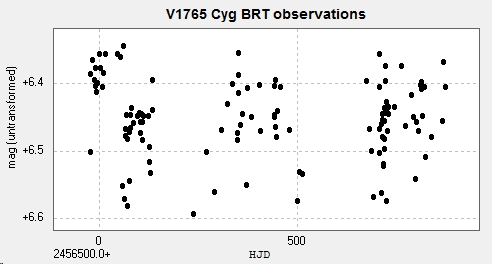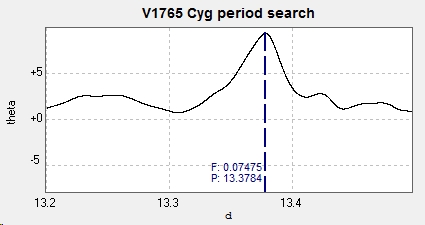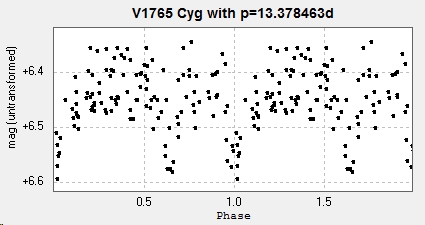V1765 Cygni / V1765 Cyg
Light curve, period search and phase diagram of the EB type eclipsing binary V1765 Cygni.
Photometry from 123 images taken by the Bradford Robotic Telescope Cluster Camera between 2013 July 2 and 2015 December 18.
The best fit period to this data is 13.378463d. This compares to the AAVSO VSX value of 13.373303 d and 13.373859d from Kreiner. (Both accessed 2016 November 17. The GCVS gives no value.)
Using this value for the period, the following phase diagram was constructed. There is a primary minimum at approximately HJD 2456482.34
Note the range of the star compared to the scatter of the data points. This was always going to be a difficult target for the BRT Cluster Camera with its inherent systematic scatter.
This close binary is unusual in having a supergiant component. The asymmetry of the secondary minimum with respect to the primary minimum is well shown. This is due to the eccentricity of the stars' orbits (e=0.335) around their common centre of mass. There is also a case to be made that some, at least, of the scatter is due to mass transfer (Meyer et al 1990) or intrinsic variations in one of the components (Percy & Khaja 1995)
This close binary is unusual in having a supergiant component. The asymmetry of the secondary minimum with respect to the primary minimum is well shown. This is due to the eccentricity of the stars' orbits (e=0.335) around their common centre of mass. There is also a case to be made that some, at least, of the scatter is due to mass transfer (Meyer et al 1990) or intrinsic variations in one of the components (Percy & Khaja 1995)
[Page updated 2016 November 17]




